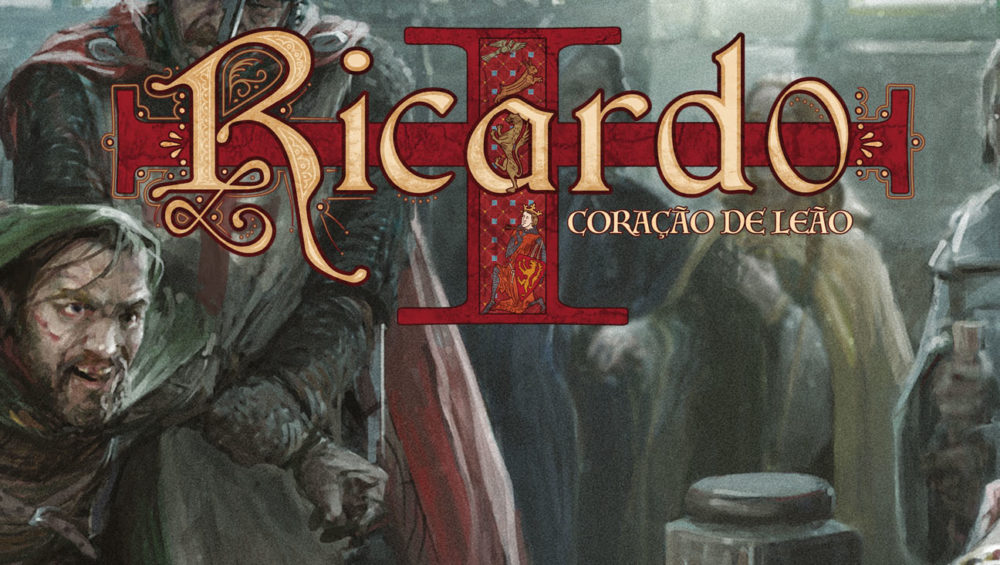If you're a modern gamer of any kind, I'm sure you've already heard about the new release of CMON's, Rising Sun. With its lavish board, tons of miniatures, and ingenious mechanics, it's been in demand lately. But what you might not know is that CMON has released a new game with a beautiful two-sided board, excellent miniatures, and also some ingenious mechanics. That game is called Richard the Lionheart, and I'm glad I didn't neglect it.
In Ricardo Coração de Leão, developed by Andrea Chiarvesio, 2 – 6 players use characters from the myth of Robin Hood which will support either the faction of King Richard, João sem Terra (Prince João) or French or Austrian in games with odd number of players. For a player to win the match, their faction must be the winner. Only then will players who supported that faction have a chance to win, individually, based on their prestige points. So, in this scenario, if you're supporting King Richard or João Sem Terra, you'll have to work together with your teammates to ensure that one of you has a chance to emerge victorious. In games with an odd number of players, one of them will play a neutral character. This player has to declare his allegiance to one of the two factions at the start of each round. The neutral player will have the opportunity to affect and manipulate the results in different ways during each round of the match. The neutral player can only win the game if neither Richard the Lionheart's faction nor Prince John's faction have won after 10 rounds, at which point any player can win the game with the most prestige points.
Speaking of winning, there are four victory tracks in the game. Each track has ten points. Two of them represent the Crusades, one of Richard and the other of Saladin (which Prince John wants victorious). The third track represents the King's Return home after the Crusades (good for King Richard's faction) and the last track represents his coffers, which Prince John wishes to squander to zero. If any one of these tracks completes its ten points, the game ends. Players who supported the defeated faction are immediately eliminated. Players from the winning faction add up their prestige points and the one with the most amount wins the game.
The mechanics are very simple. The main one is worker allocation, or more precisely, worker movement. Players will move around locations on the board, occupying spaces that will provide certain cards, prestige points or coins. Once players have moved their characters, they will be able to purchase one of numerous items to enhance movement, gain more cards, unlock their faction's special ability, or gain prestige points. After making a single market purchase, players will be required to put two cards from their hand into the influence deck without revealing them. There are six types of cards in the game, 3 from each faction. After players have placed their cards in the influence deck, the deck will be shuffled and a specified number of cards will be drawn at random. Then these cards will be revealed and accounted for affecting the game's victory tracks. If none of the trails has reached its tenth point at the end of the round, a new round starts if the tenth round has not ended (see above).
For me, Richard the Lionheart is a unique game that fills a gap in my collection. I could define it as a party game for experienced players, as well as an excellent entry-level game for novice players. Currently, most of party games are just games of deduction or trivia, usually with very simple mechanics, and don't have a good theme. Richard the Lionheart is a great theme, uses worker placement/movement mechanics, doesn't have an unknown traitor or werewolf, etc. – although you will ultimately have to earn some prestige points to win. Its well-crafted components make it appear to be a “heavy” game and generate a shine that is not present in any other game. party game that I know. But its appearance belies a relatively simple (hence entry-level) game that still offers significant choices and provides exciting results at the end of each game. Every time I played, the definition of the match was by a thread, where all the players waited for the last cards to be drawn in the hope that they had influenced enough for the results to be favorable to them.
Game play time is relatively short, around an hour, and I found a two-player game just as fun as a five-player game, for several reasons. A two-player game seems to offer more strategic control because it has less movement possibilities and more space. Meanwhile, a five-player game offers some welcome chaos and little dialogue, with players positioning their pawns in favor of their faction as the board will offer less movement due to congestion. Ricardo Coração de Leão is one of the few games that make me think about the game without actually playing. It looks great on the table and provides an immersion that makes you feel GOOD while playing. Some have complained about the price, which is pretty steep at US$ 70.00 at retail, but in relation to other forms of entertainment, six players will spend less than US$ 12.00 per person if they only play one game, which I hope is not the case. case. I certainly spent my money well buying the game and I hope it continues to be worth it. I highly recommend checking it out.
Thanks for reading and keep being nerds.
Posted by Rob Fenimore on Feb 16, 2016 on Geek Girl Authority
Translated by Kleber Bertazzo
Reviewed by Marcelo Oliveira and Cristiano Cuty
[botao_loja url=”https://www.conclaveweb.com.br/produto/ricardo-coracao-de-leao/” texto=”Learn more about this game!” icon="search"]





